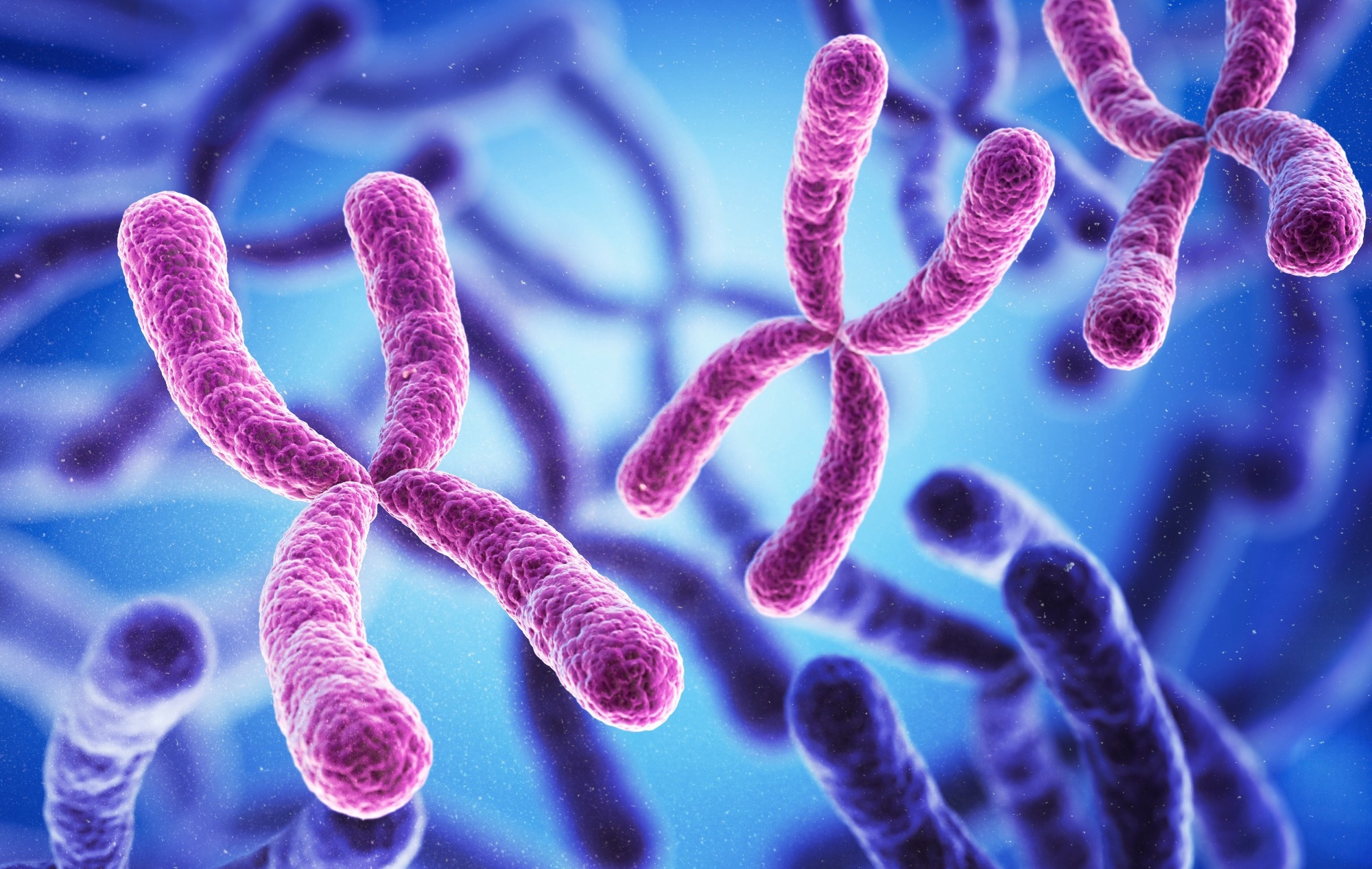History
X-linked intellectual disability (XLID) syndromes
Cause and symptoms
HUWE1 gene
Epidemiology
Diagnosis and treatment
References
Further reading
Juberg-Marsidi syndrome (JMS) is a rare, multisystem, congenital condition, first noted by Richard Juberg and Irene Marsidi in 1980. Mental retardation, stunted growth, sensory impairments, and microgenitalism are all symptoms of this condition.

Juberg-Marsidi syndrome is a recessive X-linked disorder. Image Credit: Anusorn Nakdee/Shutterstock.com
Only males have all of the physical signs and symptoms associated with JMS. JMS is a recessive X-linked disorder that affects only boys born to phenotypically normal mothers. Symptoms vary in scope and severity from person to person.
History
In 1980, Juberg and Marsidi described a family in which three males, a 4-year-old child (the proband) and his two uncles showed global developmental delay and intellectual impairment, as well as other anomalies.
At birth, they all had low growth characteristics, such as a small head circumference, a delayed bone age, and dysmorphic facial traits. The first uncle died when he was nine years old, and the second uncle died when he was ten months old.
Three brothers and two maternal uncles experienced microcephaly, severe mental impairment, spasticity, epilepsy, and deafness, according to Renier et al. (1982). Microcephaly and subnormal intellect were seen in certain heterozygous women.
According to Renier et al. (1982), the traits in their family were similar to those in the Juberg and Marsidi families (1980). Turner et al. (1994) described a large five-generation family in which numerous males had moderate to severe mental impairment, indicating that X-linked inheritance was the cause.
Several female carriers showed signs of mild mental impairment. Males and females that were hemizygous for the mutation had macrocephaly.
X-linked intellectual disability (XLID) syndromes
Neurodevelopmental X-linked intellectual disability (XLID) syndromes are caused by mutations in the E3 ligase HUWE1. HUWE1-promoted XLID syndromes are diverse, presenting with a wide variety of clinical symptoms ranging from dysmorphic facial characteristics and mild intellectual disability (ID) to severe ID and early mortality.
One of the most severe forms of XLID is Juberg-Marsidi syndrome (JMS).
Cause and symptoms
The HUWE1 gene is found on the X chromosome and is responsible for Juberg-Marsidi syndrome. HUWE1 regulates the stability of numerous proteins, which helps it play a function in a variety of important physiological processes.
This syndrome has clinical signs from birth or within the first few weeks of life. Infants with JMS have low birth weight, height, and head circumference, despite being born to full-term pregnancies. A flattened nasal bridge, dysplastic and sometimes asymmetrical ears, and a high forehead are additional dysmorphic facial traits. Bone maturation, hypotonia, and gross motor function are all delayed in JMS patients.
Furthermore, JMS children have sensory deficiencies, with the majority of them being deaf or hearing-impaired. Visual difficulties like retinal pigmentation and crossed eyes have also been reported.
JMS causes significant mental impairment in children, as evidenced by indifferent gaze, poor visual tracking, and absence or limited speech production.
Although congenital cardiac disease has been reported, it is not always included in this category. Symptoms vary in scope and severity from case to case. It is usually deadly in childhood or infancy. Undescended/atrophic testes and micropenis are common genitourinary symptoms.
HUWE1 gene
The HUWE1 gene carries a missense mutation when the syndrome is present. A missense mutation causes one of the protein's building blocks to be erroneously substituted for another, resulting in an aberrant protein. HUWE1 missense mutations have been identified, and they influence a process known as protein ubiquitination.
Reduced protein expression and altered enzyme performance may occur from HUWE1 mutations, which could influence protein ubiquitination. JMS has an X-linked recessive inheritance pattern.
Epidemiology
In the medical literature, just a few cases of JMS patients have been published. Less than one in a million newborns are thought to be affected.
Diagnosis and treatment
JMS can be detected at birth or during infancy, but because of the wide range of symptoms and similarity to other disorders, diagnosis is sometimes delayed. An initial diagnosis is made based on a thorough clinical examination, specific physical findings, and a review of the patient’s family history.
JMS has clinical similarities with the ATR-X syndrome. ATR-X (alpha-thalassemia, mental retardation, X-linked) syndrome is caused by mutations in the X-linked nuclear protein (XNP) gene. It is an extremely uncommon genetic blood condition that only affects men.
Genital abnormalities, microcephaly, severe mental impairment, neuromotor dysfunction, seizures, and hypotonia are common symptoms associated with this condition. The patient may have a ventricular septal defect and gastric reflux on occasion.
The treatment for this syndrome is tailored to the individual's specific symptoms and focuses on providing assistance to patients. The treatment for this syndrome is tailored to the individual's specific symptoms and focuses on assisting patients. Genetic counseling can benefit affected individuals and their families in understanding the condition better.
Children with JMS have a grave prognosis. There is no cure for JMS, and most patients die in their late teens or early twenties.
References
- Aprigliano R, Aksu ME, Bradamante S, et al. (2021). Increased p53 signaling impairs neural differentiation in HUWE1-promoted intellectual disabilities. Cell Reports Medicine, 2(4), 100240. doi:10.1016/j.xcrm.2021.100240. https://www.cell.com/cell-reports-medicine/fulltext/S2666-3791(21)00056-2
- Friez MJ, Brooks SS, Stevenson RE, et al. (2016). HUWE1 mutations in Juberg-Marsidi and Brooks syndromes: the results of an X-chromosome exome sequencing study. BMJ Open, 6(4), e009537. doi:10.1136/bmjopen-2015-009537. https://bmjopen.bmj.com/content/6/4/e009537
- Reynolds CR; Vannest KJ, & Fletcher-Janzen E (2013). Encyclopedia of Special Education (A Reference for the Education of Children, Adolescents, and Adults with Disabilities and Other Exceptional Individuals) || Juberg-Marsidi Syndrome.
- Juberg-marsidi syndrome. Bissonnette B, Luginbuehl I, Marciniak B, & Dalens BJ (Eds.) (2006). Syndromes: Rapid Recognition and Perioperative Implications. McGraw Hill. https://accessanesthesiology.mhmedical.com/content.aspx?bookid=852§ionid=49517747
- INTELLECTUAL DEVELOPMENTAL DISORDER, X-LINKED, SYNDROMIC, TURNER TYPE; MRXST. [Online] OMIM. Available at: https://www.omim.org/entry/309590
- Juberg-Marsidi Syndrome. [Online] National organization for rare disorders. Available at: https://rarediseases.org/rare-diseases/juberg-marsidi-syndrome/
Further Reading